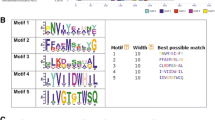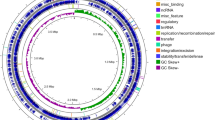Abstract
Whole-genome sequence analysis of Bacillus halodurans ATCC BAA-125 revealed an isomerase gene (rhaA) encoding an l-rhamnose isomerase (l-RhI). The identified l -RhI gene was cloned from B. halodurans and over-expressed in Escherichia coli. DNA sequence analysis revealed an open reading frame of 1,257 bp capable of encoding a polypeptide of 418 amino acid residues with a molecular mass of 48,178 Da. The molecular mass of the purified enzyme was estimated to be ∼48 kDa by sodium dodecyl sulfate-polyacrylamide gel electrophoresis and 121 kDa by gel filtration chromatography, suggesting that the enzyme is a homodimer. The enzyme had an optimal pH and temperature of 7 and 70°C, respectively, with a k cat of 8,971 min−1 and a k cat/K m of 17 min−1 mM−1 for l-rhamnose. Although l-RhIs have been characterized from several other sources, B. halodurans l-RhI is distinguished from other l-RhIs by its high temperature optimum (70°C) with high thermal stability of showing 100% activity for 10 h at 60°C. The half-life of the enzyme was more than 900 min and ∼25 min at 60°C and 70°C, respectively, making B. halodurans l-RhI a good choice for industrial applications. This work describes one of the most thermostable l-RhI characterized thus far.




Similar content being viewed by others
References
Badia J, Gimenez R, Baldoma L, Barnes E, Fessner WD, Aguilar J (1991) l-Lyxose metabolism employs the l-rhamnose pathway in mutant cells of Escherichia coli adapted to grow on l-lyxose. J Bacteriol 173:5144–5150
Barlow DJ, Thornton JM (1983) Ion-pairs in proteins. J Mol Biol 168:867–885
Bautista DA, Pegg RB, Shand PJ (2000) Effect of l-glucose and d-tagatose on bacterial growth in media and a cooked cured ham product. J Food Prot 63:71–77
Bradford MM (1976) A rapid and sensitive method for the quantitation of microgram quantities of protein utilizing the principle of protein-dye binding. Anal Biochem 72:248–254
Cai G, Zhu S, Yang S, Zhao G, Jiang W (2004) Cloning, overexpression, and characterization of a novel thermostable penicillin G acylase from Achromobacter xylosoxidans: probing the molecular basis for its high thermostability. Appl Environ Microbiol 70:2764–2770
Chakravarty S, Varadarajan R (2000) Elucidation of determinants of protein stability through genome sequence analysis. FEBS Lett 470:65–69
Costantini S, Colonna G, Facchiano AM (2008) ESBRI: a web server for evaluating salt bridges in proteins. Bioinformation 3:137–138
Declerck N, Machius M, Wiegand G, Huber R, Gaillardin C (2000) Probing structural determinants specifying high thermostability in Bacillus licheniformis alpha-amylase. J Mol Biol 301:1041–1057
Dische Z, Borenfreund E (1951) A new spectrophotometric method for the detection and determination of keto sugars and trioses. J Biol Chem 192:583–587
Dragan AI, Potekhin SA, Sivolob A, Lu M, Privalov PL (2004) Kinetics and thermodynamics of the unfolding and refolding of the three-stranded alpha-helical coiled coil, Lpp-56. Biochemistry 43:14891–14900
Fersht AR (1972) Conformational equilibria and the salt bridge in chymotrypsin. Cold Spring Harb Symp Quant Biol 36:71–73
Fu Y, Ding Y, Chen Z, Sun J, Fang W, Xu W (2010) Study on the relationship between cyclodextrin glycosyltransferase’s thermostability and salt bridge by molecular dynamics simulation. Protein Pept Lett (in press)
Gottschalk G (1986) Bacterial metabolism. Springer, New York, pp 79–81
Izumori K (2002) Bioproduction strategies for rare hexose sugars. Naturwissenschaften 89:120–124
Kabsch W, Sander C (1983) How good are predictions of protein secondary structure? FEBS Lett 155:179–82
Karshikoff A, Ladenstein R (2001) Ion pairs and the thermotolerance of proteins from hyperthermophiles: a “traffic rule” for hot roads. Trends Biochem Sci 26:550–55
Korndorfer IP, Fessner WD, Matthews BW (2000) The structure of rhamnose isomerase from Escherichia coli and its relation with xylose isomerase illustrates a change between inter and intra-subunit complementation during evolution. J Mol Biol 300:917–933
Kumar S, Nussinov R (1999) Salt bridge stability in monomeric proteins. J Mol Biol 293:1241–1255
Kumar S, Nussinov R (2004) Different roles of electrostatics in heat and in cold: adaptation by citrate synthase. Chembiochem 5:280–290
Lawson CJ, Homewood J, Taylor AJ (2002) The effects of l-glucose on memory in mice are modulated by peripherally acting cholinergic drugs. Neurobiol Learn Mem 77:17–28
Leang K, Takada G, Ishimura A, Okita M, Izumori K (2004a) Cloning, nucleotide sequence, and overexpression of the l-rhamnose isomerase gene from Pseudomonas stutzeri in Escherichia coli. Appl Environ Microbiol 70:3298–3304
Leang K, Takada G, Fukai Y, Morimoto K, Granstrom TB, Izumori K (2004b) Novel reactions of l-rhamnose isomerase from Pseudomonas stutzeri and its relation with d-xylose isomerase via substrate specificity. Biochim Biophys Acta 1674:68–77
Levin GV, Zehner LR, Sanders JP, Beadle JR (1964) Sugar substitues: their energy values, bulk characteristic, and potential health benefits. Am J Clin Nutr 62:1161–1168
Livesey G, Brown JC (1995) Whole body metabolism is not restricted to d-sugars because energy metabolism of l-sugars fits a computational model in rats. J Nutr 125:3020–3029
Moralejo P, Egan SM, Hidalgo E, Aguilar J (1993) Sequencing and characterization of a gene cluster encoding the enzymes for l-rhamnose metabolism in Escherichia coli. J Bacteriol 175:5585–5594
Mozhaev VV (1993) Mechanism-based strategies for protein thermostabilization. Trends Biotechnol 11:88–95
Musafia B, Buchner V, Arad D (1995) Complex salt bridges in proteins: statistical analysis of structure and function. J Mol Biol 254:761–770
Perutz MF (1970) Stereochemistry of cooperative effects in haemoglobin. Nature 228:726–739
Poonperm W, Takata G, Okada H, Morimoto K, Granstrom TB, Izumori K (2007) Cloning, sequencing, overexpression and characterization of l-rhamnose isomerase from Bacillus pallidus Y25 for rare sugar production. Appl Microbiol Biotechnol 76:1297–1307
Power J (1967) The l-rhamnose genetic system in Escherichia coli K-12. Genetics 55:557–568
Richardson JS, Hynes MF, Oresnik IJ (2004) A genetic locus necessary for rhamnose uptake and catabolism in Rhizobium leguminosarum bv. trifolii. J Bacteriol 186:8433–8442
Richardson JS, Carpena X, Switala J, Perez-Luque R, Donald LJ, Loewen PC, Oresnik IJ (2008) RhaU of Rhizobium leguminosarum is a rhamnose mutarotase. J Bacteriol 190:2903–2910
Ryu KS, Kim JI, Cho SJ, Park D, Park C, Cheong HK, Lee JO, Choi BS (2005) Structural insights into the monosaccharide specificity of Escherichia coli rhamnose mutarotase. J Mol Biol 349:153–162
Spek EJ, Bui AH, Lu M, Kallenbach NR (1998) Surface salt bridges stabilize the GCN4 leucine zipper. Protein Sci 7:2431–2437
Sterner R, Liebl W (2001) Thermophilic adaptation of proteins. Crit Rev Biochem Mol Biol 36:39–106
Takami H, Nakasone K, Takaki Y, Maeno G, Sasaki R, Masui N, Fuji F, Hirama C, Nakamura Y, Ogasawara N, Kuhara S, Horikoshi K (2000) Complete genome sequence of the alkaliphilic bacterium Bacillus halodurans and genomic sequence comparison with Bacillus subtilis. Nucleic Acids Res 28:4317–4331
Tomazic SJ, Klibanov AM (1988) Mechanisms of irreversible thermal inactivation of Bacillus alpha-amylases. J Biol Chem 263:3086–3091
Veith B, Herzberg C, Steckel S, Feesche J, Maurer KH, Ehrenreich P, Baumer S, Henne A, Liesegang H, Merkl R, Ehrenreich A, Gottschalk G (2004) The complete genome sequence of Bacillus licheniformis DS13, an organism with great industrial potential. J Mol Microbiol Biotechnol 7:204–211
Vieille C, Epting KL, Kelly RM, Zeikus JG (2001) Bivalent cations and amino-acid composition contribute to the thermostability of Bacillus licheniformis xylose isomerase. Eur J Biochem 268:6291–6301
Wasserman B (1984) Thermostable enzyme production. Food Technol 38:78–88
Whitlow M, Howard AJ, Finzel BC, Poulos TL, Winborne E, Gilliland GL (1991) A metal-mediated hydride shift mechanism for xylose isomerase based on the 1.6 A Streptomyces rubiginosus structures with xylitol and d-xylose. Proteins 9:153–173
Xiao L, Honig B (1999) Electrostatic contributions to the stability of hyperthermophilic proteins. J Mol Biol 289:1435–1444
Yip KS, Britton KL, Stillman TJ, Lebbink J, de Vos WM, Robb FT, Vetriani C, Maeder D, Rice DW (1998) Insights into the molecular basis of thermal stability from the analysis of ion-pair networks in the glutamate dehydrogenase family. Eur J Biochem 255:336–346
Yoshida H, Yamada M, Ohyama Y, Takada G, Izumori K, Kamitori S (2007) The structures of l-rhamnose isomerase from Pseudomonas stutzeri in complexes with l-rhamnose and d-allose provide insights into broad substrate specificity. J Mol Biol 365:1505–1516
You DJ, Fukuchi S, Nishikawa K, Koga Y, Takano K, Kanaya S (2007) Protein thermostabilization requires a fine-tuned placement of surface-charged residues. J Biochem 142:507–516
Acknowledgment
This research was supported by Basic Science Research Program through the National Research Foundation of Korea funded by the Ministry of Education, Science and Technology (2009-0070463). This study was also supported by a grant (2008A0080126) from ARPC, Republic of Korea.
Author information
Authors and Affiliations
Corresponding authors
Additional information
Ponnandy Prabhu and Thanh Thi Ngoc Doan contributed equally to this work.
Electronic supplementary material
Below is the link to the electronic supplementary material.
Supplementary Table 1
Salt bridge forming residues in the α-helix of BHRI, ECRI, and YPRI (DOC 38 kb)
Rights and permissions
About this article
Cite this article
Prabhu, P., Doan, T.T.N., Jeya, M. et al. Cloning and characterization of a rhamnose isomerase from Bacillus halodurans . Appl Microbiol Biotechnol 89, 635–644 (2011). https://doi.org/10.1007/s00253-010-2844-4
Received:
Revised:
Accepted:
Published:
Issue Date:
DOI: https://doi.org/10.1007/s00253-010-2844-4




